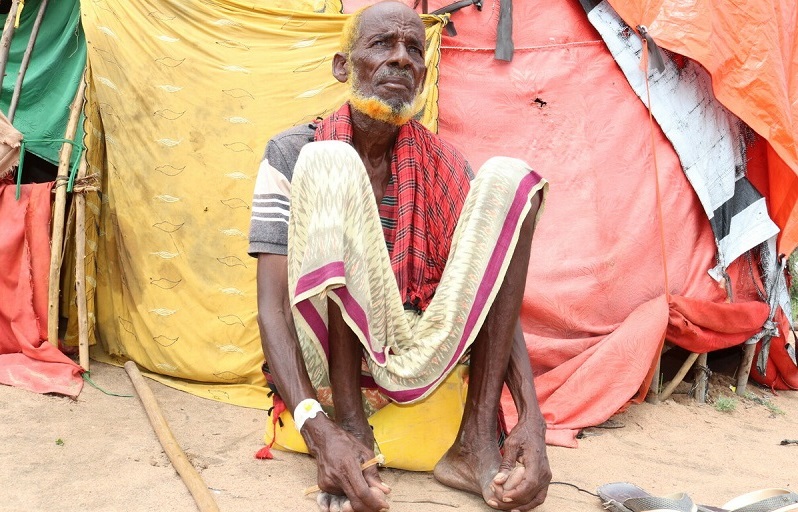War in Ukraine is compounding a hunger crisis across East Africa as drought grips the region and food prices soar, aid agencies have warned.
The Horn of Africa is facing one of its most severe droughts in recent history. Three consecutive rainy seasons have failed to materialise since October 2020 and below-average rainfall is forecast again March-May.
Jane Meriwas, a pastoralist and the founder and executive director of the Samburu Women Trust in Kenya, spoke at an event in Nairobi, Kenya on Tuesday.
“Trauma is real and people are suffering in silence,” said Meriwas. “Let’s not close our eyes and say that Africa is not suffering and focus a lot on Ukraine. Let’s not turn a blind eye to this crisis because all of us are equal.”
Anti-poverty charity Oxfam warns that average or below-average rains March-May will push up to 20 million people into severe food insecurity in Kenya, Ethiopia and Somalia. Up to eight million more people are expected to go hungry in South Sudan, which is facing a fifth consecutive year of severe flooding.
Russia’s invasion of Ukraine is making things worse by impeding the wheat trade. The two countries account for about a quarter of the world’s wheat exports. That includes the supply of around 90% of East Africa’s imported wheat.
Wheat accounts for a third of the average national cereal consumption in East Africa, 84% of which is met by imports. Wheat prices have soared 80% since the invasion and further disruption is expected.
Comment: Climate finance should not be made to compete with aid to Ukraine
A drought over four consecutive rainy seasons would be “unprecedented” since records began around 1920, Chris Funk, director of the Climate Hazards Center, at the University of California Santa Barbara, told Climate Home News.
Funk explained that dry spells in eastern Africa are linked to La Niña, a weather pattern that is driven by the cooling of ocean waters in the eastern Pacific.
Human-caused climate change has contributed to the warming of the western pacific, which in turn strengthens La Niña and increases the probability of drought in East Africa.
Exceptionally warm air in the region from December to February also played a role, drying up water holes on which many pastoralists communities rely. Crop production in the region is down by as much as 70%.
Vulnerable people including women, girls, the elderly and the disabled in pastoralists communities are particularly at risk of starvation as millions of livestock have died across the region, said Modi Mbaraza, executive director of the Young Women Christian Association of South Sudan.

Carcass of a dead cow in the drought-affected village of Dhoobley in Jubaland state, Somalia (Photo: Osman Hussein / Oxfam)
The Covid-19 pandemic, ballooning government debt, a desert locust plague and conflict have weakened people’s safety nets.
Global food prices reached an all-time high in February, before Russia’s invasion of Ukraine. The war is widely expected to push them even higher.
The Famine Early Warning Systems Network estimates that the number of people in need of food assistance is 70% higher than during the previous food crisis of 2016-2017.
Considering the size of wheat demand and reliance on imports from Russia and Ukraine, the World Food Programme predicts that Sudan, Kenya and Ethiopia will be the hardest hit from the shock to the global wheat trade.
The price of sunflower oil, another widely used commodity, has also been impacted by the conflict. Russia and Ukraine account for nearly three quarters of global exports.
In Ethiopia, a week after the Russian invasion, the price of sunflower oil rose by 215%, said Gezahegn Kebede, country director of Oxfam Ethiopia, speaking of the “direct impact” of the war on the hunger crisis.

The Ali family has had to flee their home following clashes in Ethiopia are struggling to survive caught between conflict, drought and a plague of desert locusts (Photo: Petterik Wiggers / Oxfam)
Even if the rains do arrive this month, millions of people will go hungry unless preventative actions is taken now, humanitarian groups say.
“The crisis in Ukraine, which is causing so much suffering there, is also amplifying suffering across the world,” said Gabriela Bucher, executive director of Oxfam International.
“The brutal truth is at the moment Africa is not on the global agenda. 2022 cannot be the year in which hundreds of thousands die from an avoidable hunger crisis in East Africa.”
Oxfam is urging grain exporters to do all they can to make up for the reduced supply from Ukraine to poorer countries.
The charity is further calling on governments to inject funds into a $6bn UN humanitarian appeal for Ethiopia, Somalia and South Sudan. Only 3% has been funded to date, while Kenya has only secured 11% of its UN flash appeal.
